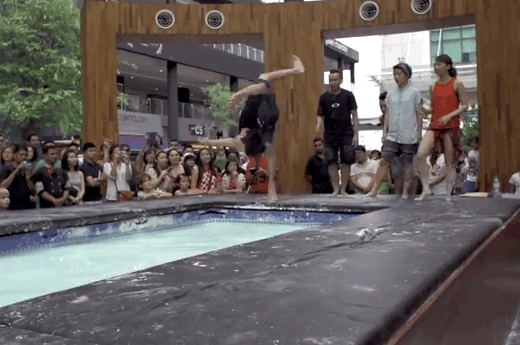A viral video shows people in Kuala Lumper, Malaysia, walking across the liquid below.
They also danced on it:
Flipped on it:
Played soccer on it:
And rode a bike across it:
Sort of.
A substance called non-Newtonian fluid makes all these actions possible. Specifically, the pool above is filled with about 2,100 gallons of a cornstarch and water mixture known as "oobleck" - a homage to Dr. Seuss' book, "Bartholomew and Oobleck."
Non-Newtonian fluids act differently than other liquids, such as water. When pressured by say, the weight of someone walking across it, these substances become solids momentarily, according a paper published in the journal Nature in 2012. This includes things like blood, ketchup, and toothpaste.
The oobleck gets these properties because of the cornstarch. In general, starches don't dissolve in water. Instead, the particles curl up and cling together to form very tiny non-squishy particles.
When pressure is applied (by a person's foot or a bike, for instance) the cornstarch particles get pushed down on top of each other and the water is squeezed out from between them. The particles can actually become so thickly jammed together that they form a solid, the researchers found.
But the substance won't stay solid for long. Once energy stops being transferred to the liquid (a foot is lifted into the air) the particles are no longer squeezed together. Water fills in gaps between the particles and the oobleck returns to a more liquid state.
In the video, when people ran across the pool, cornstarch platforms formed around their feet. Once they stopped putting a downward force into their step, the particles and water rearranged themselves. The solid zone started to melt away. Basically, the only way not to get stuck in or fall through the oobleck is to continue applying force to the particles.
That's why the oobleck initially supported the bike's weight in the video, but enveloped the frame moments later when the biker slowed down.
This is also why you can walk across sand, but start to sink when you stay in one place for too long.
Particles also have to be a certain size to successfully solidify. Small molecules don't get pushed together on impact because they can move out of the way faster than larger particles - like the ones in oobleck.
For example, milk is a mixed solution, but it doesn't behave like oobleck because the particles of proteins and fats in it just aren't large enough.
Particles in non-Newtonian substances have to be about at least one micron (or one one-millionth of a meter, roughly the size of some bacteria) to solidify. The starch particles in the oobleck are between 5 and 20 microns wide, the researchers found.
Ultimately, this explains why you can't walk on water, but can on oobleck. The viscosity, or thickness, in "normal" fluids (like water) stays constant. The particles just move out of the way instead of getting mashed together by your body's momentum.
Check out the full video, a genius advertisement from Hong Leong Bank, below:
h/t Laughing Squid





